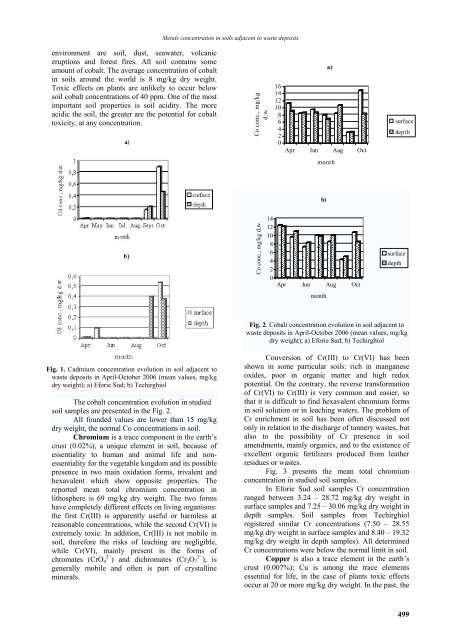2007_6_Nr6_EEMJ
You also want an ePaper? Increase the reach of your titles
YUMPU automatically turns print PDFs into web optimized ePapers that Google loves.
Metals concentration in soils adjacent to waste deposits<br />
environment are soil, dust, seawater, volcanic<br />
eruptions and forest fires. All soil contains some<br />
amount of cobalt. The average concentration of cobalt<br />
in soils around the world is 8 mg/kg dry weight.<br />
Toxic effects on plants are unlikely to occur below<br />
soil cobalt concentrations of 40 ppm. One of the most<br />
important soil properties is soil acidity. The more<br />
acidic the soil, the greater are the potential for cobalt<br />
toxicity, at any concentration.<br />
Co conc., mg/kg<br />
d.w.<br />
16<br />
14<br />
12<br />
10<br />
8<br />
6<br />
4<br />
2<br />
0<br />
a)<br />
Apr Iun Aug Oct<br />
month<br />
surface<br />
depth<br />
b)<br />
Co conc., mg/kg d.w.<br />
14<br />
12<br />
10<br />
8<br />
6<br />
4<br />
2<br />
0<br />
Apr Iun Aug Oct<br />
month<br />
surface<br />
depth<br />
Fig. 2. Cobalt concentration evolution in soil adjacent to<br />
waste deposits in April-October 2006 (mean values, mg/kg<br />
dry weight); a) Eforie Sud; b) Techirghiol<br />
Fig. 1. Cadmium concentration evolution in soil adjacent to<br />
waste deposits in April-October 2006 (mean values, mg/kg<br />
dry weight); a) Eforie Sud; b) Techirghiol<br />
The cobalt concentration evolution in studied<br />
soil samples are presented in the Fig. 2.<br />
All founded values are lower than 15 mg/kg<br />
dry weight, the normal Co concentrations in soil.<br />
Chromium is a trace component in the earth’s<br />
crust (0.02%), a unique element in soil, because of<br />
essentiality to human and animal life and nonessentiality<br />
for the vegetable kingdom and its possible<br />
presence in two main oxidation forms, trivalent and<br />
hexavalent which show opposite properties. The<br />
reported mean total chromium concentration in<br />
lithosphere is 69 mg/kg dry weight. The two forms<br />
have completely different effects on living organisms:<br />
the first Cr(III) is apparently useful or harmless at<br />
reasonable concentrations, while the second Cr(VI) is<br />
extremely toxic. In addition, Cr(III) is not mobile in<br />
soil, therefore the risks of leaching are negligible,<br />
while Cr(VI), mainly present in the forms of<br />
chromates (CrO 4 2− ) and dichromates (Cr 2 O 7 2− ), is<br />
generally mobile and often is part of crystalline<br />
minerals.<br />
Conversion of Cr(III) to Cr(VI) has been<br />
shown in some particular soils: rich in manganese<br />
oxides, poor in organic matter and high redox<br />
potential. On the contrary, the reverse transformation<br />
of Cr(VI) to Cr(III) is very common and easier, so<br />
that it is difficult to find hexavalent chromium forms<br />
in soil solution or in leaching waters. The problem of<br />
Cr enrichment in soil has been often discussed not<br />
only in relation to the discharge of tannery wastes, but<br />
also to the possibility of Cr presence in soil<br />
amendments, mainly organics, and to the existence of<br />
excellent organic fertilizers produced from leather<br />
residues or wastes.<br />
Fig. 3 presents the mean total chromium<br />
concentration in studied soil samples.<br />
In Eforie Sud soil samples Cr concentration<br />
ranged between 3.24 – 28.72 mg/kg dry weight in<br />
surface samples and 7.25 – 30.06 mg/kg dry weight in<br />
depth samples. Soil samples from Techirghiol<br />
registered similar Cr concentrations (7.50 – 28.55<br />
mg/kg dry weight in surface samples and 8.40 – 19.32<br />
mg/kg dry weight in depth samples). All determined<br />
Cr concentrations were below the normal limit in soil.<br />
Copper is also a trace element in the earth’s<br />
crust (0.007%); Cu is among the trace elements<br />
essential for life, in the case of plants toxic effects<br />
occur at 20 or more mg/kg dry weight. In the past, the<br />
499


